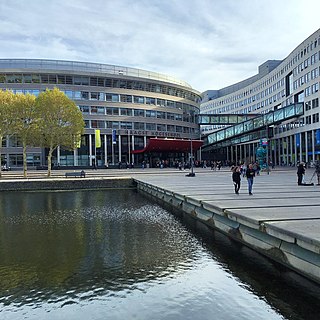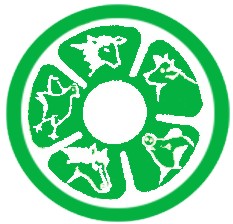
A Master of Science is a master's degree. In contrast to the Master of Arts degree, the Master of Science degree is typically granted for studies in sciences, engineering and medicine and is usually for programs that are more focused on scientific and mathematical subjects; however, different universities have different conventions and may also offer the degree for fields typically considered within the humanities and social sciences. While it ultimately depends upon the specific program, earning a Master of Science degree typically includes writing a thesis.
The European Credit Transfer and Accumulation System (ECTS) is a standard means for comparing academic credits, i.e., the "volume of learning based on the defined learning outcomes and their associated workload" for higher education across the European Union and other collaborating European countries. For successfully completed studies, ECTS credits are awarded. One academic year corresponds to 60 ECTS credits that are normally equivalent to 1500–1800 hours of total workload, irrespective of standard or qualification type. ECTS credits are used to facilitate transfer and progression throughout the Union. ECTS also includes a standard grading scale, intended to be shown in addition to local standard grades.

The Bologna Process is a series of ministerial meetings and agreements between European countries to ensure comparability in the standards and quality of higher-education qualifications. The process has created the European Higher Education Area under the Lisbon Recognition Convention. It is named after the University of Bologna, where the Bologna declaration was signed by education ministers from 29 European countries in 1999. The process was opened to other countries in the European Cultural Convention of the Council of Europe, and government meetings have been held in Prague (2001), Berlin (2003), Bergen (2005), London (2007), Leuven (2009), Budapest-Vienna (2010), Bucharest (2012), Yerevan (2015), Paris (2018), and Rome (2020).
Doctor of Medicine is a medical degree, the meaning of which varies between different jurisdictions. In the United States, and some other countries, the M.D. denotes a professional degree. This generally arose because many in 18th-century medical professions trained in Scotland, which used the M.D. degree nomenclature. In England, however, Bachelor of Medicine, Bachelor of Surgery (M.B.B.S.) was used and eventually in the 19th century became the standard in Scotland too. Thus, in the United Kingdom, Ireland and other countries, the M.D. is a research doctorate, honorary doctorate or applied clinical degree restricted to those who already hold a professional degree (Bachelor's/Master's/Doctoral) in medicine. In those countries, the equivalent professional degree to the North American, and some others' usage of M.D. is still typically titled Bachelor of Medicine, Bachelor of Surgery.
A medical school is a tertiary educational institution, professional school, or forms a part of such an institution, that teaches medicine, and awards a professional degree for physicians. Such medical degrees include the Bachelor of Medicine, Bachelor of Surgery, Master of Medicine, Doctor of Medicine (MD), or Doctor of Osteopathic Medicine (DO). Many medical schools offer additional degrees, such as a Doctor of Philosophy (PhD), master's degree (MSc) or other post-secondary education.
A postgraduate diploma is a postgraduate qualification awarded after a university degree, which supplements the original degree and awards them with a graduate diploma. Countries that award postgraduate diplomas include but are not limited to Bangladesh, Barbados, Belgium, Brazil, Canada, Chile, Colombia, Germany, Hong Kong, Jamaica, Spain, Kenya, South Africa, Sudan, India, Israel, Ireland, the Netherlands, New Zealand, Nigeria, Republic of Panama the Philippines, Portugal, Russia, Pakistan, Poland, Saudi Arabia, Singapore, Sweden, the United Kingdom, Sri Lanka, Trinidad and Tobago and Zimbabwe. Level of education and recognition differ per issuing country.
A Doctor of Pharmacy is a professional doctorate in pharmacy. In some countries, it is a doctoral degree to practice the profession of pharmacy or to become a clinical pharmacist. In many countries, people with their Doctor of Pharmacy are allowed to practice independently and can prescribe drugs directly to patients. A PharmD program has significant experiential and/or clinical education components in introductory and advanced levels for the safe and effective use of drugs. Experiential education prepares graduates to be practice-ready, as they already have spent a significant amount of time training in areas of direct patient care and research.
A course credit is a measure of the size of an educational course, often used to determine whether the requirements for an award have been met, to facilitate transfer between institutions, or to enhance intercomparability of qualifications. Credit may be input-based – defined by the quantity of instruction given – or outcome-based – defined by the learning outcomes and a notional time to achieve those outcomes.
In Italy, the laurea is the main post-secondary academic degree. The name originally referred literally to the laurel wreath, since ancient times a sign of honor and now worn by Italian students right after their official graduation ceremony and sometimes during the graduation party. A graduate is known as a laureato, literally "crowned with laurel."

Medical education in Australia includes the educational activities involved in the initial and ongoing training of Medical Practitioners. In Australia, medical education begins in Medical School; upon graduation it is followed by a period of pre-vocational training including Internship and Residency; thereafter, enrolment into a specialist-vocational training program as a Registrar eventually leads to fellowship qualification and recognition as a fully qualified Specialist Medical Practitioner. Medical education in Australia is facilitated by Medical Schools and the Medical Specialty Colleges, and is regulated by the Australian Medical Council (AMC) and Australian Health Practitioner Regulation Agency (AHPRA) of which includes the Medical Board of Australia where medical practitioners are registered nationally.
Credit Accumulation and Transfer Scheme (CATS) is used by many universities in the United Kingdom to monitor, record and reward passage through a modular degree course and to facilitate movement between courses and institutions. One UK credit is equivalent to the learning outcomes of 10 notional hours of study, thus a university course of 150 notional study hours is worth 15 credits, and a university course of 300 notional study hours is worth 30 credits. A full academic year is worth 120 credits and a full calendar year (normally only at postgraduate level) 180 credits. CATS schemes in use in Higher Education in the UK include CATS (England & Northern Ireland), SCOTCAT (Scotland), the Credit and Qualifications Framework for Wales credit framework (Wales), the Learning and Skills Development Agency credit framework and Open College Network credits.
An admission to practice law is acquired when a lawyer receives a license to practice law. In jurisdictions with two types of lawyer, as with barristers and solicitors, barristers must gain admission to the bar whereas for solicitors there are distinct practising certificates.
The University of Medicine and Pharmacy of Craiova is a tertiary educational institution in the city of Craiova, in south-western Romania.

Engineering education is the activity of teaching knowledge and principles to the professional practice of engineering. It includes an initial education, and any advanced education and specializations that follow. Engineering education is typically accompanied by additional postgraduate examinations and supervised training as the requirements for a professional engineering license. The length of education, and training to qualify as a basic professional engineer, is typically five years, with 15–20 years for an engineer who takes responsibility for major projects.

The Hague University of Applied Sciences is a university of applied sciences with its campuses located in and around The Hague in the Randstad metropolitan region in the west of the Netherlands. The city is home to the Dutch government, royal family and many major international legal, security and peace institutions. Since the university was founded in 1987 it has expanded to four campuses in the near-side cities of The Hague, Delft and Zoetermeer. The main campus in The Hague is located behind The Hague Hollands Spoor railway station by the Laakhaven Canal.
Medical education in France is administered by departments within universities called Unités de formation et de recherche de médecine (UFR). The training takes a minimum of ten years after the baccalauréat and concludes with the defence of a clinical thesis. Upon the successful presentation of their thesis, the medical student is awarded a diplôme d'études spécialisées (DES), based on their specialty. Certain high-achievers are awarded a diplôme d'études spécialisées complémentaire (DESC).
The Technological Educational Institute (TEI) of Central Greece was a university founded in 2013, had a main campus 15.81 acres (0.0640 km2) in the City of Lamia, Phthiotis, Central Greece, and four branch campuses. An institution of higher education of the State University System of Greece, having full self governance and functions under the supervision of the Ministry of Education, laws 2916 on 11-6-2001 and 3549 on 20-3-2007. The Technological Institute of Central Greece has abolished on 29 January 2019 and ceased to be a university in its own name status by an Act of Hellenic Parliament, Law 4589/29-1-2019. Educational departments absorbed by the Agricultural University of Athens (AUA), National and Kapodistrian University of Athens (NKUA), University of Thessaly (UTH).
The Brevet de technicien supérieur (BTS) senior technologist’s certificate is a national diploma of higher education in France, established in 1959.
Acıbadem University School of Medicine is one of the graduate schools of Acıbadem University. Acıbadem University is a private, non-profit institution, founded in 2007 and located in Istanbul, Turkey. The University is supported by the financial resources of the Kerem Aydınlar Foundation, set up by Mehmet Ali Aydınlar. Mehmet Ali Aydınlar is a leading Turkish businessman and the largest shareholder and CEO of the Acıbadem Healthcare Group, Turkey's leading healthcare institution that was founded in 1992.

The Faculty of Biotechnical Sciences is a public higher education and research institution in the area of biotechnical sciences, located in Bitola, Republic of Macedonia. It was established in 1999 and provides education up to doctoral level. Many of its graduates enter the food industry.





